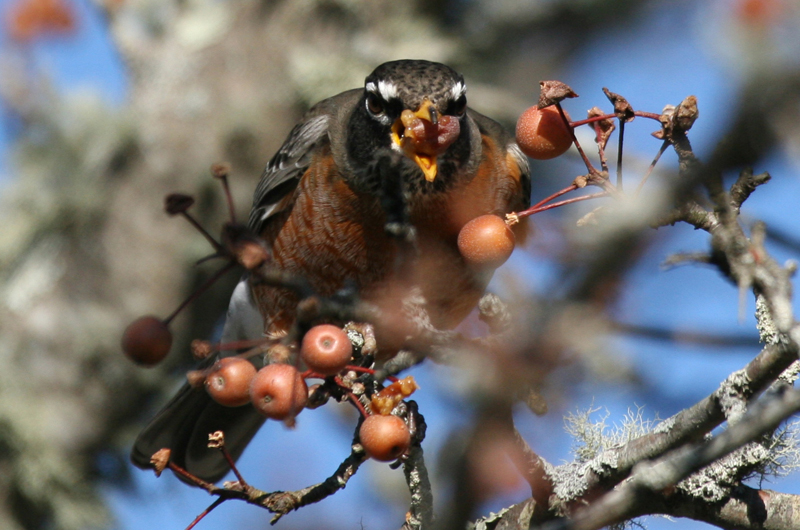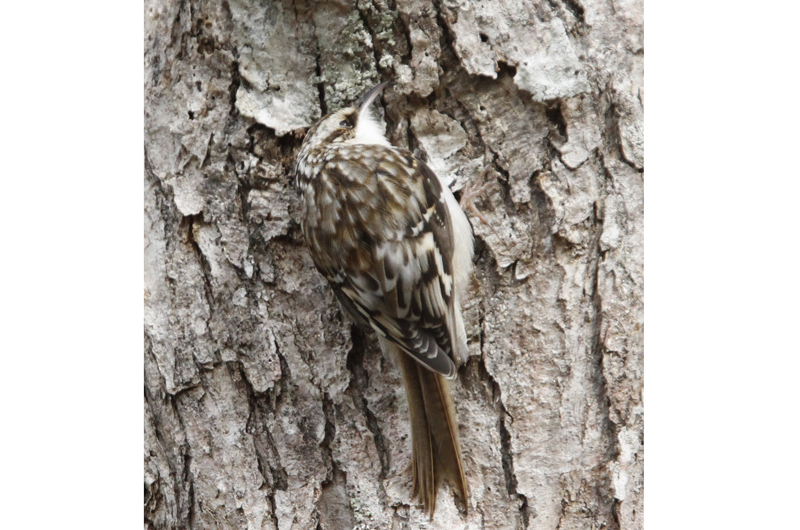A recurring theme this week is that cold weather, wind, snow and ice make birds show up in some unexpected places and do unexpected things.

On Feb. 15, Pat Ingalls emailed to report a flock of a dozen or so snow buntings in an unusual location — in her yard visiting her feeder. Upon questioning, she reports that she was referencing six different bird books and the Internet; they all supported her identification. This is an interesting sighting since we normally think of this species as a denizen of beaches and large open fields rather than yards and feeders. Linsey Lee also reports a flock of snow buntings in a more typical location, in the fields at Seven Gates Farm.
Joanie Ames has also observed an adult Cooper’s hawk that regularly visits her Chilmark yard; on Feb. 22, she observed a strange behavior — the bird was eating some layer pellets for domestic ducks that she had cleaned out of her duck house!
This winter weather has made life difficult for robins and other species that feed on the ground. Flocks of them are in multiple locations around the Island, from Aquinnah to Chappaquiddick to East Chop. They are feeding along the edges of the roads, as in many places these are the only areas of open ground. They are also scavenging holly berries and other fruits that are not covered by the snow. Anne Lemenager also reports cedar waxwings eating some of the few berries that are still around.
Open water is also scarce, so ducks are showing up in odd places. Jessica Burnham is hosting a mallard that seems to be living in her barn as of Feb. 18. And Nancy Dole reports a female bufflehead crashed into a snowbank in her (inland) yard; the next day she was able to release the bird at Lagoon Pond. Soo Whiting and Flip Harrington found a female red-breasted merganser walking down Quansoo Road; they gave her a lift back to the open waters of Tisbury Great Pond.
Bird Sightings
David Finklestein was visiting Squibnocket Beach the other day when he found a dead male common eider that was banded. The band number was reported to the federal Fish and Wildlife Service, so we now know that the bird was banded in Lockeport, Nova Scotia, on August 19, 1998. We do not know whether it was banded as a chick or an adult, so it was at least 16 and a half years old, while other data shows eiders may live to be 20 years. Longevity data on eiders and other sea ducks is especially difficult to come by because of their oceanic haunts. Since most bands are never recovered, please report any and all banded birds you find.
It is somewhat unusual for us to see gulls that do not have any black on their wing tips, so Ken Magnuson’s Feb. 11 sighting of an adult Kumlien’s race of Iceland gull is interesting. It was found at the entrance of Oak Bluffs harbor.
Ron Domurat observed a great blue heron and an immature bald eagle flying over Slough Cove of Edgartown Great Pond on Feb. 13. Both species have similarly huge wingspans.
Peter Guest posted a video on YouTube of a woodcock he found a short way west of the Katama boat launch ramp on Feb. 13. I find it surprising because the bird appears to be healthy; it is quite chubby and waddles around as well as a woodcock can, and it flies off at the end of the video. It must have found places where the ground is not frozen so it can find food.
On Feb. 19, Ken Magnuson came across a first-year peregrine falcon that was feeding on a male bufflehead. Also on the hawk front, Richard Toole reports an adult Cooper’s hawk in the Chappaquonsett area of Vineyard Haven. Linsey Lee also reports a Cooper’s hawk visiting her feeder. And Beth Mayhew observed an immature Cooper’s in a more typical pose, eyeing a bird feeder and waiting for an unlucky victim to come by.
Anne Lemenager found a brown creeper on East Chop on Feb. 21. I had one at my house on Feb. 19; it actually perched on the deck railing for a few seconds, but I did not see it visit the suet feeder. Luanne Johnson has also observed them recently — sometimes she even has two of them!
More expected feeder visitors are fox sparrows, which have been spotted by both Susan Straight and Wendy Weldon in Chilmark. Soo Whiting had a brown thrasher visiting her feeder on Feb. 19. Flickers have been visiting feeders as well. Kate Greer observed one at her Wasque thistle feeder, and I have one regularly visiting my suet. Interesting that both are females; are there any male flickers (with black malar stripe by their beaks) around?
On Feb. 19, Matt Pelikan examined the ducks hanging out in the open water near the drawbridge and found a male Barrow’s goldeneye in with the common goldeneye, red-breasted mergansers, bufflehead and eiders. Ken Magnuson found the Barrow’s again later that afternoon. Mr. Pelikan also reminds us to look for birds while on the Steamship Authority ferries. He reports 11 species of ducks in Woods Hole harbor on Feb. 21, including a large flock of scaup, all three scoters, long-tailed duck, common eider, bufflehead, common goldeneye, red-breasted merganser, mallard and black duck.
Michael Ditchfield found an adult black-crowned night-heron wading in the Mattakesett Herring Creek on Feb. 21.
Cookie Gazaille Perry reports a red-breasted nuthatch at her feeder on Feb. 22, a first for her yard. There are numerous other reports of this nuthatch. Luanne Johnson observed one on the 15th, also a first for her yard. Jo-Anne Eccher had observed one at her Aquinnah feeder through the winter.
Many people report hearing birds singing, even on these cold mornings — a positive note suggesting that spring may eventually come. Also note that migrant red-winged blackbirds are scheduled to show up in late February.
There are lots of birds around, so please get out looking for them, and be sure to report your bird sightings to birds@mvgazette.com.
Robert Culbert leads guided birding tours and is an ecological consultant living in Vineyard Haven.





Comments
Comment policy »